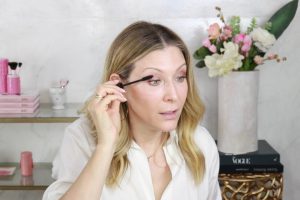Lately, the skin barrier has been in the spotlight. That shouldn’t come as a surprise, since this all-important lipid layer of skin is essential for keeping external factors (like allergens, irritants, and pollutants) out of the skin, and essential components (like moisture) within the skin.
One big way it pulls that off? Something called ceramides. For the uninitiated, “ceramides are lipids that are naturally occurring in the skin,” says NakedPoppy skin specialist Tara Parenti. “They help to strengthen the skin barrier, prevent moisture loss, and protect from environmental aggressors.” Ultimately, they ensure that the skin barrier functions properly, helping you maintain healthy, dewy skin.
The only downside? Ceramides aren’t invincible — or always readily available in skin. With that in mind, here’s what you need to know about these good fats, and how to get more of them.
The scoop on ceramides:
- Ceramides make up 50% of the lipid matrix
- Ceramides keep hydration in and environmental aggressors out
- Sun exposure, over-cleansing, and age can lead to low ceramides
- Low ceramide levels can lead to eczema, acne, and other conditions
- Everyone can (and should!) use ceramides in skincare
What are ceramides?
We can’t really talk about ceramides without first discussing the skin barrier. “For skin to function properly as a barrier with the environment, the outermost layer of the skin — that is, the stratum corneum — consists of a lipid matrix,” says NakedPoppy research scientist Marisa Plescia. (FYI: Lipids are fats that include oils, fatty acids, cholesterol, and ceramides.)
This lipid matrix has two big jobs: First, it prevents excessive water loss from the skin, and secondly, it protects the body from the environmental compounds we mentioned earlier.
As part of this lipid matrix, ceramides have some big responsibilities — in fact, they account for 50% of it. “They play a central role in skin structure and maintaining a healthy skin barrier,” says Plescia. “Their main role is supporting healthy skin barrier function by helping to prevent transepidermal water loss, or water loss through skin, and stimulating the production of keratinocytes, which make keratin, a structural support protein of the skin.” [1] All to say: They’re kind of a big deal.
What are the benefits of ceramides?
Clearly, ceramides are important — for everyone. But as we mentioned, they’re not invincible. Everything from age to your cleansing habits can impact the ceramide levels in your skin, which in turn impairs the skin barrier.
“Studies have shown the exposure to external factors, such as the ingredients used in cleansers and sanitizers, environmental pollutants, harsh climate, and UV exposure can all affect the composition of the lipids in the stratum corneum and lead to lower ceramide levels,” Plescia says. [2] Age can also play a factor, with ceramide production slowing as skin matures.
Not only can having fewer ceramides on hand lead to dry skin, but “lower ceramide levels can be linked to many skin concerns, such as acne, rosacea, eczema, and psoriasis,” she says. The connection? The fewer ceramides you have, the higher the rate of TEWL. That can lead to inflammation in the skin, which in turn contributes to these conditions.
But wait, we have good news! “If someone’s skin is compromised, ceramides will help to refortify and rebuild the skin barrier,” says Parenti, who considers them a must-have if you experience burning, stinging, or itching sensations, as well as persistent redness. In other words, you can make up for those low ceramide levels by supplementing them with ceramide-rich products — and, in doing so, beef up your barrier.
Not only that, but ceramides are one of those magical ingredients that works for everyone and anyone, too. “There is no downside to adding ceramides into your routine,” Plescia says.
If you’re not sure where ceramides can fit in your skincare routine, we’ve got you covered. Just take our easy, 3-minute beauty assessment to get your customized recommendations.
How should you use ceramides in your routine?
While they’re most often found in moisturizers — for obvious reasons — you can also find ceramides in many leave-on products, from mists to serums. The most common types include ceramide NG, ceramide NP, ceramide AP, ceramide EOP, and phytosphingosine, says Plescia.
Also great: Plant-based versions, often called phyto-ceramides, abound. In Fitglow Beauty Sea Ceramide Toning Mist, you can find ceramides paired with hyaluronic acid, that humectant that offsets TEWL by drawing in and retaining many times its weight in water. And in Fitglow Beauty Night Lip Serum, the organic, plant-based ceramides are especially helpful, as the skin on the lips doesn’t have the same oil glands as that on the rest of the face — making them more prone to dryness.
The beauty of ceramides is that they can only make things (namely, your skin) better. If that’s not a compelling reason to incorporate them into your routine, we’re not sure what is.
Get “shockingly accurate” clean beauty picks. Take your beauty assessment.
Shop the Story:
References
[1] “Their main role is supporting a healthy skin barrier function by helping to prevent transepidermal water loss and stimulating the production of keratinocytes, which make keratin, a structural support protein of the skin.”
https://lipidworld.biomedcentral.com/articles/10.1186/s12944-016-0178-7
[2] “Studies have shown the exposure to external factors, such as the ingredients used in cleansers and sanitizers, environmental pollutants, harsh climate, and UV exposure can all affect the composition of the lipids in the stratum corneum and lead to lower ceramide levels,” Plescia says.






Comments